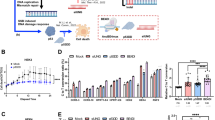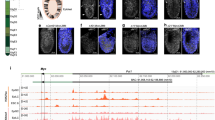Abstract
Adult hematopoietic and other tissue stem cells have highly constrained cell cycling that limits their susceptibility to standard gene therapy vectors, which depend upon chromosomal integration. Using cytokine cocktails to increase transduction efficiency often compromises subsequent stem cell function in vivo. We previously showed that p21Waf1/Cip1/Sdi1 (p21) mediates stem cell quiescence in vivo and decreasing its expression ex vivo leads to an expansion of stem cell pool in vivo. Here, we report that application of p21 specific siRNA increased the gene transduction efficiency in hematopoietic stem cells while preserving cell multipotentiality. Both types of siRNA, synthesized siRNA and transcribed shRNA, reduced p21 expression in target cells by 85–98%. The effect of RNAi in these cells was transient and the level of p21 mRNA returned to base line 14–28 days after siRNA treatment. This brief interval of reduction, however, was sufficient to increase transduction efficiency to two- to four-fold in cell cultures, and followed by a seven- to eight-fold increase in mice. The RNAi treated, lentivector-transduced CD34+ cells retained multipotentiality as assessed in vitro by colony formation assay and in vivo by NOD/SCID mouse transplantation assay. Reduction of p21 resulted in an increased chromosomal integration of lentivector into target cellular DNA. Taken together, both synthesized and transcribed siRNA knocked down p21 expression in human CD34+ hematopoietic stem/progenitor cells. Silencing p21 expression increased gene transduction efficiency and vector integration while retaining stem cell multipotentiality. Thus, RNAi targeting of p21 is a useful strategy to increase stem cell gene transfer efficiency. Decreasing p21 expression transiently while increasing gene-transfer vector integration may ultimately facilitate clinical applications of gene therapy.
This is a preview of subscription content, access via your institution
Access options
Subscribe to this journal
Receive 12 print issues and online access
$259.00 per year
only $21.58 per issue
Buy this article
- Purchase on Springer Link
- Instant access to full article PDF
Prices may be subject to local taxes which are calculated during checkout




Similar content being viewed by others
References
Uchida N et al. HIV, but not murine leukemia virus, vectors mediate high efficiency gene transfer into freshly isolated G0/G1 human hematopoietic stem cells. Proc Natl Acad Sci USA 1998; 95: 11939–11944.
Metcalf D . Lineage commitment and maturation in hematopoietic cells: the case for extrinsic regulation. Blood 1998; 92: 345–347.
Zandstra PW, Lauffenburger DA, Eaves CJ . A ligand-receptor signaling threshold model of stem cell differentiation control: a biologically conserved mechanism applicable to hematopoiesis. Blood 2000; 96: 1215–1222.
Case SS et al. Stable transduction of quiescent CD34(+)CD38(−) human hematopoietic cells by HIV-1-based lentiviral vectors. Proc Natl Acad Sci USA 1999; 96: 2988–2993.
Kohn DB et al. A clinical trial of retroviral-mediated transfer of a rev-responsive element decoy gene into CD34(+) cells from the bone marrow of human immunodeficiency virus-1-infected children. Blood 1999; 94: 368–371.
Kohn DB . Gene therapy for haematopoietic and lymphoid disorders. Clin Exp Immunol 1997; 107 (Suppl 1): 54–57.
Miyoshi H et al. Transduction of human CD34+ cells that mediate long-term engraftment of NOD/SCID mice by HIV vectors. Science 1999; 283: 682–686.
Sutton RE, Reitsma MJ, Uchida N, Brown PO . Transduction of human progenitor hematopoietic stem cells by human immunodeficiency virus type 1-based vectors is cell cycle dependent.J Virol 1999; 73: 3649–3660.
Guenechea G et al. Transduction of human CD34+ CD38- bone marrow and cord blood-derived SCID-repopulating cells with third-generation lentiviral vectors. Mol Ther 2000; 1: 566–573.
An DS et al. Lentivirus vector-mediated hematopoietic stem cell gene transfer of common gamma-chain cytokine receptor in rhesus macaques. J Virol 2001; 75: 3547–3555.
Zack JA et al. HIV-1 entry into quiescent primary lymphocytes: molecular analysis reveals a labile, latent viral structure. Cell 1990; 61: 213–222.
Matsumura I et al. Thrombopoietin-induced differentiation of a human megakaryoblastic leukemia cell line, CMK, involves transcriptional activation of p21(WAF1/Cip1) by STAT5. Mol Cell Biol 1997; 17: 2933–2943.
Novina CD et al. siRNA-directed inhibition of HIV-1 infection. Nat Med 2002; 8: 681–686.
Fairbrother WG, Yeh RF, Sharp PA, Burge CB . Predictive identification of exonic splicing enhancers in human genes. Science 2002; 297: 1007–1013.
Dykxhoorn DM, Novina CD, Sharp PA . Killing the messenger: short RNAs that silence gene expression. Nat Rev Mol Cell Biol 2003; 4: 457–467.
Matzke M, Matzke AJ . RNAi extends its reach. Science 2003; 301: 1060–1061.
Kittler R, Buchholz F . RNA interference: gene silencing in the fast lane. Semin Cancer Biol 2003; 13: 259–265.
Cheng T et al. Hematopoietic stem cell quiescence maintained by p21cip1/waf1. Science 2000; 287: 1804–1808.
Stier S et al. Ex vivo targeting of p21Cip1/Waf1 permits relative expansion of human hematopoietic stem cells. Blood 2003; 102: 1260–1266.
Dao MA, Taylor N, Nolta JA . Reduction in levels of the cyclin-dependent kinase inhibitor p27(kip-1) coupled with transforming growth factor beta neutralization induces cell-cycle entry and increases retroviral transduction of primitive human hematopoietic cells. Proc Natl Acad Sci USA 1998; 95: 13006–13011.
Homo sapiens CDK-interaction protein 1; wild-type p53-activated fragment 1; DNA synthesis. XM_166412 NCBI (2002) NCBI Annotation Project [Online].
Sui G et al. A DNA vector-based RNAi technology to suppress gene expression in mammalian cells. Proc Natl Acad Sci USA 2002; 99: 5515–5520.
Miyagishi M, Taira K . U6 promoter-driven siRNAs with four uridine 3′ overhangs efficiently suppress targeted gene expression in mammalian cells. Nat Biotechnol 2002; 20: 497–500.
Zhang JL et al. The bis-azo compound FP-21399 inhibits HIV-1 replication by preventing viral entry. Virology 1998; 244: 530–541.
Zandstra PW, Lauffenburger DA, Eaves Connie J . A ligand-receptor signaling threshold model of stem cell differentiation control: a biologically conserved mechanism applicable to hematopoiesis. Blood 2000; 96: 1215–1222.
Hong Y et al. Factors affecting retrovirus-mediated gene transfer to human CD34+ cells. J Gene Med 2004; 6: 724–733.
Hofmann W et al. Species-specific, postentry barriers to primate immunodeficiency virus infection. J Virol 1999; 73: 10020–10028.
Parolin C, Taddeo B, Palu G, Sodroski J . Use of cis- and trans-acting viral regulatory sequences to improve expression of human immunodeficiency virus vectors in human lymphocytes. Virology 1996; 222: 415–422.
Zhang J, Crumpacker CS . Human immunodeficiency virus type 1 nucleocapsid protein nuclear localization mediates early viral mRNA expression. J Virol 2002; 76: 10444–10454.
Butler SL, Hansen MS, Bushman FD . A quantitative assay for HIV DNA integration in vivo. Nat Med 2001; 7: 631–634.
O'Doherty U et al. A sensitive, quantitative assay for human immunodeficiency virus type 1 integration. J Virol 2002; 76: 10942–10950.
Butera ST et al. Oscillation of the human immunodeficiency virus surface receptor is regulated by the state of viral activation in a CD4+ cell model of chronic infection. J Virol 1991; 65: 4645–4653.
User bulletin #2. Rev B. ABI prism 7700 sequence detection system. Applied Biosystems. Foster City, CA, 2001. http://www.appliedbiosystems.com/support/contact.
Acknowledgements
We wish to thank Dr Joseph Sodroski for the generous gift of the lentivector and Dr Jason La Bonte for help in preparing the lentivector pool and titration of the recombinant virus; Drs Gregor Adams, Randolf Forkert, and Chou-Wen Lin for helpful suggestions on mouse model study, Yin Shao for performing mouse tail vein injection, LiYing Ma for laboratory technical support. This work was supported by National Institutes of Health AI055313 (JLZ) and HL044851-13 (DTS).
Author information
Authors and Affiliations
Rights and permissions
About this article
Cite this article
Zhang, J., Attar, E., Cohen, K. et al. Silencing p21Waf1/Cip1/Sdi1 expression increases gene transduction efficiency in primitive human hematopoietic cells. Gene Ther 12, 1444–1452 (2005). https://doi.org/10.1038/sj.gt.3302544
Received:
Accepted:
Published:
Issue Date:
DOI: https://doi.org/10.1038/sj.gt.3302544
Keywords
This article is cited by
-
Expression profile of host restriction factors in HIV-1 elite controllers
Retrovirology (2013)
-
Cytoplasmic p21 is a potential predictor for cisplatin sensitivity in ovarian cancer
BMC Cancer (2011)
-
Hematopoietic stem and progenitor cells in HIV/AIDS and immune reconstitution
Cell Research (2010)
-
The CDK inhibitors: potential targets for therapeutic stem cell manipulations?
Gene Therapy (2008)
-
The Genetic Engineering of Hematopoietic Stem Cells: the Rise of Lentiviral Vectors, the Conundrum of the LTR, and the Promise of Lineage-restricted Vectors
Molecular Therapy (2007)



